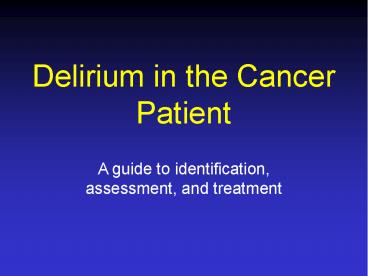Delirium in the Cancer Patient - PowerPoint PPT Presentation
Title:
Delirium in the Cancer Patient
Description:
Title: Palliative Care in Winnipeg Author: Paul J Daeninck Last modified by: User Created Date: 11/14/1998 4:56:30 AM Document presentation format – PowerPoint PPT presentation
Number of Views:528
Avg rating:3.0/5.0
Title: Delirium in the Cancer Patient
1
Delirium in the Cancer Patient
- A guide to identification, assessment, and
treatment
2
Delirium
- Definition
- Recognition
- Screening/diagnostic tools
- Etiologic factors
- Treatment of underlying cause
- Prevention
3
Definition
- Etiologically non-specific global cerebral
dysfunction associated with changes in LOC,
attention, thinking, perception, memory,
psychomotor behavior, emotion and the sleep/wake
cycle
4
DSM-IV Criteria
- A) Change in consciousness with reduced ability
to focus, sustain or shift attention - B) Change in cognition (e.g., memory,
disorientation, change in language, perceptual
disturbance) that is not dementia - C) Abrupt onset (hours to days) with fluctuation
- D) Evidence of medical condition judged to be
etiologically related to disturbance
5
Characteristics
- Abrupt onset
- Disorientation, fluctuation of symptoms
- Hypoactive vs hyperactive vs mixed
- Early signs often mistaken as
- anger, anxiety, depression, psychosis
6
Delirium Types
- Hypoactive
- confusion, somnolence, ? alertness
- Hyperactive
- agitation, hallucinations, aggression
- Mixed (gt60)
- features of both
7
Prevalence of Delirium
- Common in terminally ill
- Steifel et al 20 of medical in-pts
- Massie et al gt75 terminally ill
- Pereira et al 44 on admission
- 62 at death
- 30 reversible
8
Incidence
- Gagnon et al, (J Pall Care 1998)
- 89 consecutive pts, CRS used
- 20 delirious on admission
- 30-40 during stay
- 44 reversed, gt50 died in delirium
- Assd with high opioid dose
9
Incidence
- Lawlor et al (J Pall Care 1998)
- 103 pts, MDAS used
- 50 of episodes reversible
- Terminal delirium in 88
- Hyperactive (3) vs hypoactive (47)
- Mixed (48) most common
10
Delirium vs Dementia
- Delirium
- Impaired memory
- Impaired judgement
- Impaired thinking
- Disorientation
- Dementia
- Impaired memory
- Impaired judgement
- Impaired abst thinking
- Impaired cortical fn
- Disorientation
11
Delirium vs Dementia
- Delirium
- Abrupt onset
- Decreased LOC
- Sleep/wake cycle ?
- Reversible
- Dementia
- Insidious, progressive
- Alert, LOC intact
- Minimal ?
- Irreversible
12
Screening Tools
- Delirium Rating Scale
- temporal onset
- perceptual ?
- hallucinations
- psychomotor behavior
- cognitive status
- mood lability
- variability of symptoms
- MMSE
- orientation
- registration
- attention/calculation
- recall
- language
13
Causes
CNS effects tumour seizures RT Indirect M
etabolic Ca Na, Na K Mg
O2, CO2
14
Causes
- Infection
- pneumonia, sepsis
- Hematologic
- ? Hgb, ? WBC, ? protein
- Metabolic encephalopathy
- organ failure, paraneoplastic syndromes
15
Causes
- Endocrine
- hyper/hypothyroidism, Cushing syndrome
- Drug withdrawal
- alcohol, narcotics, hallucinogens
- Immunologic
- SLE, vasculitis
- Nutritional deficiencies
16
Drug Causes
- Chemotherapy
- MTX, 5FU, VCR/VBL, Bleo, Plat, IL-2
- Steroids
- Opioids
- BZD, phenothiazines
- Anti-cholinergics (Gravol, Elavil)
- Anti-virals
17
Opioid-Induced Neurotoxicity (OIN)
- Neuropsychiatric syndrome
- Cognitive dysfunction
- Delirium
- Hallucinations
- Myoclonus/seizures
- Hyperalgesia/allodynia
18
OIN Risk Factors
- High opioid doses
- Prolonged opioid treatment
- Borderline cognition/delirium
- Dehydration
- Renal failure
- Psychoactive drugs
- Advanced age
19
Treatment
- Stop any offending Rx
- Hydration (oral, IV, SC)
- Correct metabolic abnormalities
- Structured setting
- quiet room, low lights, calendar, clock
- Family support
20
Treatment
- Opioid rotation
- Adjunct medications
- haloperidol (Haldol) 0.5-5 mg q2-4 h
PO/SC/IV/IM - MTMZ (Nozinan) 12.5-50 mg q2-4 h
PO/SC/IM - midazolam (Versed) 1-20 mg q2 h SC/IV or
30-100 mg/24 h CSCI or CIVI
21
Sedation in Terminal Delirium
Mild haloperidol 1-2 mg PO/SC q8h plus q1h
prn Moderate haloperidol 2.5 - 5 mg SC
q4h plus q1h prn midazolam 2.5 - 5
mg Severe haloperidol 5 mg SC
q4h plus q1h prn midazolam 5 - 20 mg OR CSCI
or CIVI haloperidol 1.25 mg/hr
midazolam 1.25 - 5 mg/hr
22
Prevention
- Staff and family awareness
- Structured settings
- Minimize use of medications
- Opioid rotation
- Hydration
23
Algorithm
Agitation ? cognition ? LOC
Confirm with tool MMSE/DRS/CRS
Reversible cause? Investigations
Interventions Medications Prevention































